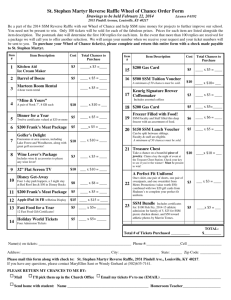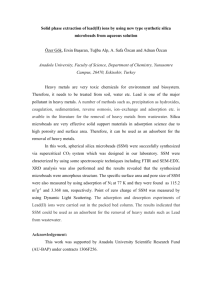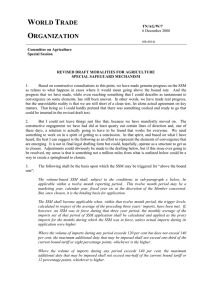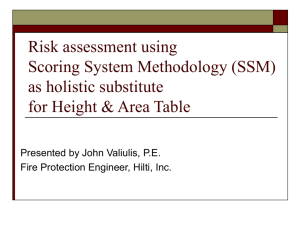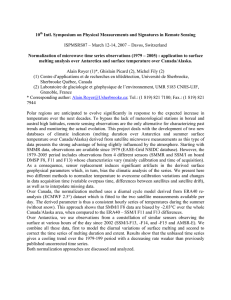DOSE-MORTALITY RESPONSE OF “SUSCEPTIBLE” TO AVID AND MALATHION. A PRE-EMPTIVE STRATEGY
advertisement
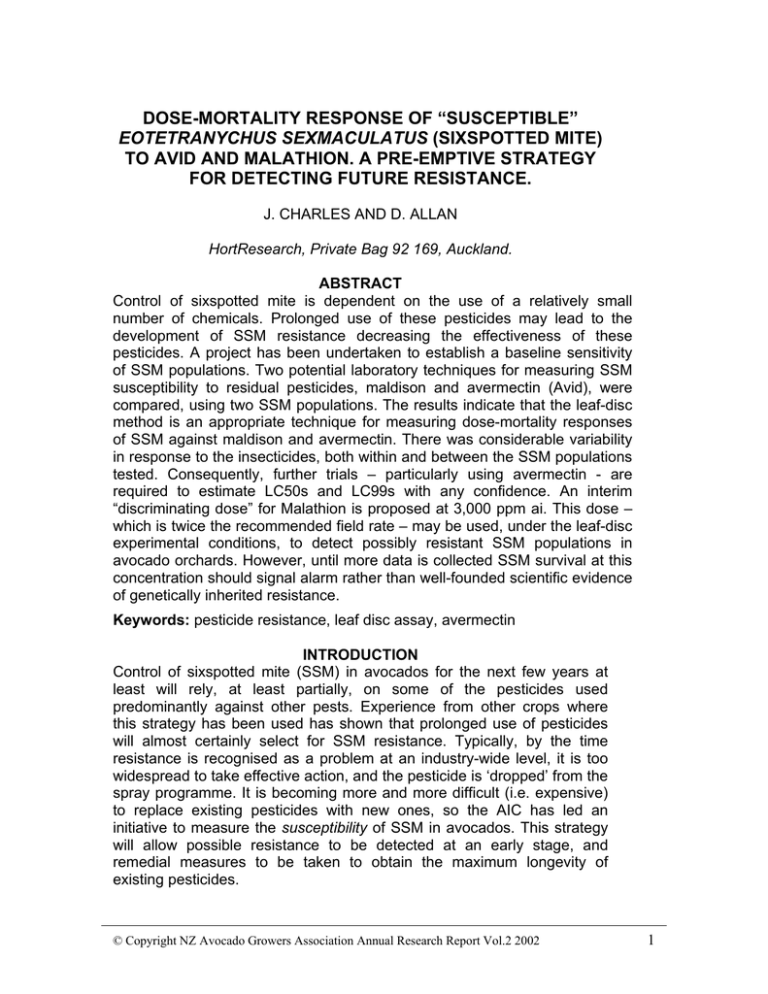
DOSE-MORTALITY RESPONSE OF “SUSCEPTIBLE” EOTETRANYCHUS SEXMACULATUS (SIXSPOTTED MITE) TO AVID AND MALATHION. A PRE-EMPTIVE STRATEGY FOR DETECTING FUTURE RESISTANCE. J. CHARLES AND D. ALLAN HortResearch, Private Bag 92 169, Auckland. ABSTRACT Control of sixspotted mite is dependent on the use of a relatively small number of chemicals. Prolonged use of these pesticides may lead to the development of SSM resistance decreasing the effectiveness of these pesticides. A project has been undertaken to establish a baseline sensitivity of SSM populations. Two potential laboratory techniques for measuring SSM susceptibility to residual pesticides, maldison and avermectin (Avid), were compared, using two SSM populations. The results indicate that the leaf-disc method is an appropriate technique for measuring dose-mortality responses of SSM against maldison and avermectin. There was considerable variability in response to the insecticides, both within and between the SSM populations tested. Consequently, further trials – particularly using avermectin - are required to estimate LC50s and LC99s with any confidence. An interim “discriminating dose” for Malathion is proposed at 3,000 ppm ai. This dose – which is twice the recommended field rate – may be used, under the leaf-disc experimental conditions, to detect possibly resistant SSM populations in avocado orchards. However, until more data is collected SSM survival at this concentration should signal alarm rather than well-founded scientific evidence of genetically inherited resistance. Keywords: pesticide resistance, leaf disc assay, avermectin INTRODUCTION Control of sixspotted mite (SSM) in avocados for the next few years at least will rely, at least partially, on some of the pesticides used predominantly against other pests. Experience from other crops where this strategy has been used has shown that prolonged use of pesticides will almost certainly select for SSM resistance. Typically, by the time resistance is recognised as a problem at an industry-wide level, it is too widespread to take effective action, and the pesticide is ‘dropped’ from the spray programme. It is becoming more and more difficult (i.e. expensive) to replace existing pesticides with new ones, so the AIC has led an initiative to measure the susceptibility of SSM in avocados. This strategy will allow possible resistance to be detected at an early stage, and remedial measures to be taken to obtain the maximum longevity of existing pesticides. © Copyright NZ Avocado Growers Association Annual Research Report Vol.2 2002 1 MATERIAL AND METHODS Two potential laboratory techniques for measuring SSM susceptibility to residual pesticides were compared. Petri dish method (Bowie et al, 1988). A 2 ml aqueous suspension of water (controls) or pesticide at different multiples of the recommended field rate was sprayed from a Potter Tower (100 kPa with a 10 second settling time) on to each of the lids and bases of 50 ml diameter petri dishes. The treated petri dishes were allowed to dry at ambient laboratory temperature (c. 22o C for 1 h). Adult female SSM (n=10) were transferred to the centre of the base of the petri dish with a fine camel hair brush, and the tight fitting lid replaced. Dishes were stored at c. 22o C and a 16 hours light:8 hours dark photoperiod for 24 hours when mortality was assessed. Mites were gently prodded with a fine brush. Those unable to walk more than 1 body length were considered to be dead. Leaf-disc method Freshly picked avocado leaves from an unsprayed tree were placed under a Potter Tower. The underside of the leaves were sprayed as above, and allowed to dry. Leaf discs 18 mm in diameter were cut with a cork borer and floated on water, ventral side up, with cotton wool support in a 9 cm diameter petri dish. Five SSM were added to each disc. Dishes were stored at c. 22o C and a 16 hours light:8 hours dark photoperiod and mortality assessed after 24 hours, as above. A feature of the leaf-disc method is that test-mites are free to run off the disc on to the water-soaked cotton wool where they become trapped. If the mites regularly exhibit this behaviour, then the technique may be criticised for not truly measuring, or overestimating, mortality. To explore the behaviour of SSM further, the mites on the water sprayed discs were observed over a 7 day period. Using the leaf-disc method, the responses to the two insecticides of two populations of SSM - one collected from grapes on Waiheke Island in the Hauraki Gulf, the other collected from an organic Avocado orchard in Katikati – were measured and compared. Neither population had been previously sprayed with either insecticide. Data relating mortality to pesticide dose were analysed by probit analysis. RESULTS AND DISCUSSION Petri dish method All SSM in the treated dishes were dead. Control mortality was also very high (>99%), leading to the clear conclusion that this technique was not suitable for testing responses of this delicate mite species. © Copyright NZ Avocado Growers Association Annual Research Report Vol.2 2002 2 Leaf-disc method Control mortality was very low after 24 hours, and did not significantly increase up to 7 days. Only a very few mites on unsprayed leaves crawled off the leaves on to the water and drowned. The great majority remained on the leaf disc, fed and reproduced. Consequently, the SSM behaviour that resulted in individuals crawling off the leaves was regarded as a treatment effect. Thus all mites that left the leaf discs were considered to have died as a result of the treatment effect. Losses from the pesticide treatments were corrected for control losses during the analysis. The data indicated that the slopes of the responses to Malathion were similar, but that the doses required to kill 50 and 99% of the Katikati population were about twice those required to kill the same numbers of SSM from Waiheke (Table 1). In the absence of further data it is not possible to determine whether the different response was due to experimental or genetic variation. The response of the Waiheke population to Malathion allowed a diagnostic dose to this insecticide to be proposed, at 3,000 ppm ai. This is twice the recommended field rate for Malathion (1,500 ppm ai), and about 3 times the higher 95% confidence limit for the LC99 of the Waiheke population. Any SSM that survived exposure to this dose (under these experimental conditions) could reliably be considered ‘resistant’ to Malathion – at least with respect to the Waiheke population. The response to Avid of SSM from Waiheke was very variable, so that the LC50 and LC90 values could not be provided with confidence limits (Table 1). None of the mites from Katikati were killed by Avid, despite a series of bioassays using gradually increasing concentrations of Avid up to nearly ten times that required to kill 50% of the mites from Waiheke. The variability in the responses of both populations means that it is not possible to say whether they are equal (but very variable), or that the Katikati population is already ‘resistant’ compared with that from Waiheke. Further tests of several more populations would be required to determine this. The assay showed the quite different mode of action of the two pesticides. Mites killed by maldison died within a few hours and mortality after 24 hours was easily measured. Mites killed by avermectin remained alive for longer, and, even when presumed to be dead after 24 hours, retained turgidity. Additionally, more SSM in the avermectin trial were lost from the leaf-disc. As a result of this variability, additional testing with avermectin may be required before resistance can be estimated with confidence. © Copyright NZ Avocado Growers Association Annual Research Report Vol.2 2002 3 Table 1: Responses of ‘never-been-sprayed’ populations of SSM to Malathion and Avid Malathion statistics Waiheke 1 (n = 310 ) slope + se LC50 (ppm ai) (95%CL) LC99 (ppm ai) (95%CL) diagnostic dose (ppm ai) Avid Katikati Waiheke 1 (n = 100 ) 1 (n = 370 ) Katikati (n = 1951) 5.0 ± 0.57 4.6 ± 1.0 1.93 ± 0.28 - 262.0 457 0.29 - (225-297) * * - 762 1473 4.68 - (626-1033) * * - 3000 - - - (n1 = total number of SSM represented by the statistics; this is much lower than the actual number tested, because many assays with 0 or 100% mortality were not included in the analysis. * 95% confidence limits were not be calculated for these estimates because of high variability in the data) SUMMARY The leaf-disc method is an appropriate technique for measuring dosemortality responses of SSM against maldison and avermectin. The response of mites from Waiheke to maldison allowed a diagnostic dose to this insecticide to be proposed, at 3000 ppm ai. This is twice the recommended field rate for Malathion 50EC (1500 ppm ai), and about 3 times the upper 95% confidence limit for the LC99 of the Waiheke population. Any SSM that survived exposure to this dose (under these experimental conditions) could reliably be considered ‘resistant’ to maldison – at least with respect to the Waiheke population. SSM responses to avermectin were very variable, and further testing of mites from different populations is required to obtain a discriminating dose for avermectin. REFERENCES Bowie, M.H.; Chapman, R.B.; Walker, J.T.S. 1988. Monitoring azocyclotin and propargite resistance in European red mite. Proceedings of the 41st New Zealand Weed and Pest Control Conference: 189 – 192 © Copyright NZ Avocado Growers Association Annual Research Report Vol.2 2002 4
